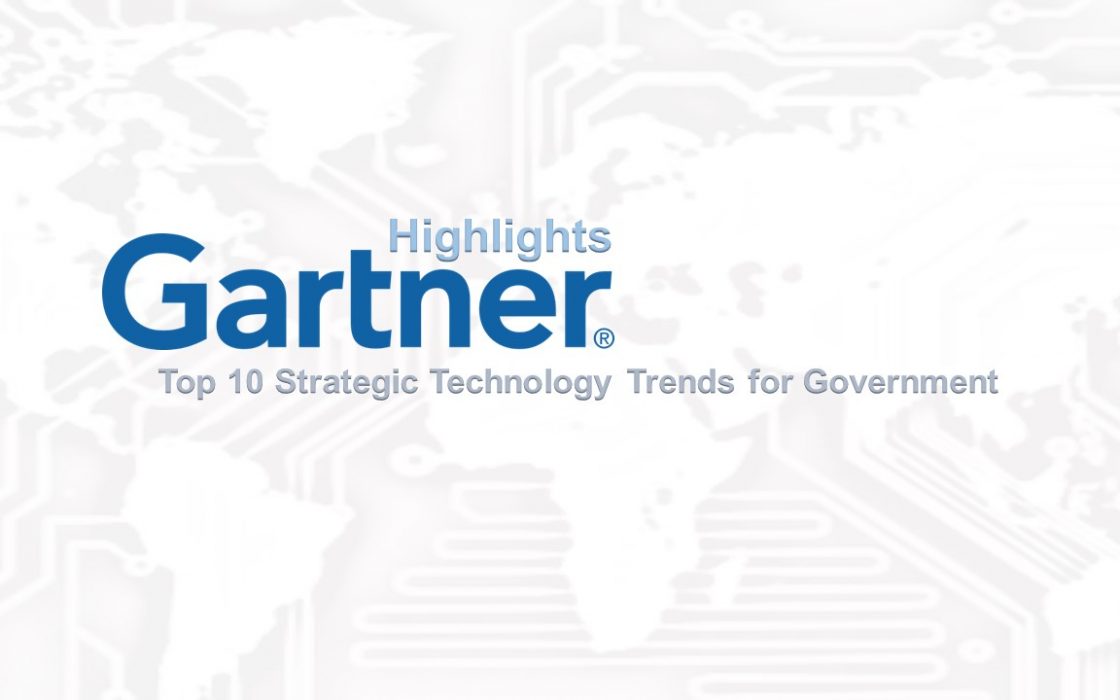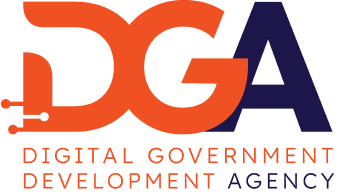Gartner Highlights Top 10 Strategic Technology Trends for Government

SYDNEY, Australia, June 3, 2015
Gartner Highlights Top 10 Strategic Technology Trends for Government
Focus on Digital Government as Global Public Sector Technology Spending Declines in 2015
ที่มา: http://www.gartner.com/newsroom/id/3069117
คลิกที่นี่เพื่อเลือกอ่านบทความภาษาไทย
Technologies that enable new service models for digital government must be at the top of the list for government organizations as they prioritize technology investments, according to Gartner, Inc.
Gartner has identified the 10 most important technology trends for government in 2015 in order to help CIOs and IT leaders assess critical strategic technologies and plan their enterprises' or agencies' IT roadmaps.
Spending by national, federal and local governments worldwide on technology products and services is forecast to decline 1.8 percent from $439 billion to $431 billion in 2015, growing to $475.5 billion by 2019.
Gartner research director Rick Howard said organizational culture, legacy IT systems and business processes, stretched IT budgets, and the lack of critical IT skills are among the inhibitors for government CIOs when evaluating and selecting new technology or sourcing options.
"Public sector CIOs can gain support for digital innovation from public officials and administrators by explaining digital innovation in terms of business priorities and presenting relevant examples of what the consumer service industry or other digitally savvy government agencies have done, how they have done it, and what the results have been," said Mr. Howard.
"These strategic technology trends have substantial disruptive potential that is just beginning to materialize and will reach an inflection point within the next three to five years," said Mr. Howard. "Public sector CIOs can capitalize on the value of these trends by first determining how they will impact government program operations or service delivery models, and then by building the organizational capabilities and capacity needed to support them."
1) Digital Workplace
The government workforce of the future will be populated with digitally literate employees, from frontline workers to top-level executives. The digital workplace is open, flat and democratic. It is the organizational manifestation of open government. CIOs and IT leaders must take a leadership role in building a more social, mobile, accessible and information-driven work environment.
2) Multichannel Citizen Engagement
Government jurisdictions with multiple channels (municipal offices, physical mail correspondence, contact centers, e-government websites and mobile apps) are struggling to provide their citizens with one coherent view of the enterprise. A multichannel strategy, in the context of digital government, means more than delivering a seamless experience to stakeholders. It also is about delivering interactions that are connected, consistent, convenient, collaborative, customized, clear and transparent. To produce those outcomes, policymakers and CIOs must radically redesign service models by combining traditional marketing tools (such as focus groups, user experience labs, surveys and stakeholder analysis) with new approaches (such as citizen co-creation initiatives, agile development and design thinking).
3) Open Any Data
The number and variety of public-facing open datasets and Web APIs published by all tiers of governments worldwide continue to increase. Gartner's view is that government open data is here to stay, but it will take a decade or more before its maximum utility is realized.
The rapid growth of open datasets among early mover organizations and flat or declining budgets create sustainability challenges to government open data programs. Open data is not free. For most government agencies, open data programs are an unfunded or underfunded cost center. The "value" of open data must become tangible to government in terms of how its availability can quantifiably contribute to operational efficiency or effectiveness, let alone how it supports economic development, national productivity or commercial ventures. Gartner predicts that by 2018, more than 30 percent of digital government projects will treat any data as open data.
4) Citizen e-ID
Citizen electronic identification (e-ID) refers to an orchestrated set of processes and technologies managed by governments to provide a trusted domain for how public services will be accessed by citizens on any device or through any online channel (Web, mobile devices or applications) — and, in some cases, using smart card readers attached to PCs or kiosks. It has been a long-standing yet elusive goal of many government planners to provide citizens with integrated and seamless access to all government services.
To be successful, citizen e-ID programs require a trusted relationship between government and commercial vendors, with a focus on business value, interoperability and user experience. Regardless of whether a government agency serves as the primary citizen e-ID identity broker or contracts with a commercial identity and access management as a service (IDaaS) provider, CIOs must ensure that personal privacy and data confidentiality requirements are met.
5) Edge Analytics
Analytics is rapidly evolving from a separate and distinct business function into a fluid aspect of system operations and user experiences. The capabilities of edge analytics are particularly relevant as government CIOs and agency program leaders design new mobile services that are augmented by situational context and real-time interactions.
Edge analytics possess three distinct characteristics. Primarily, they are advanced — they apply predictive and prescriptive algorithms and cognitive computing to make real-time assessments about what will happen or what should happen. Second, edge analytics are pervasive. They are embedded into business processes and applications to deliver responsive and agile organizational performance. Finally, edge analytics are invisible. They operate continuously in the background, tracking user activity, processing sensor and environmental data, dynamically adjusting workflows to enhance the user experience, or managing activities during events as they unfold.
6) Scalable Interoperability
Government agencies are starting to increasingly rely on data exchange with external partners in order to optimize their service delivery networks and business functions, such as cross-boundary collaboration and service coordination, monitoring and outcome reporting.
Scalable interoperability offers government CIOs, enterprise architects and business process analysts an incremental, "just enough" approach to architecture and standards to deliver "soon enough" value. By narrowing the scope of interoperability initiatives, a motivated community of interest — that is, stakeholders who receive tangible benefits from improved data exchange — can agree to use application-neutral and source-neutral extensible identifiers, formats and protocols to achieve mutual goals.
7) Digital Government Platforms
In digital business, citizens should no longer have to navigate among various agencies and programs through vertical, first generation e-government Web portals in order to locate the services they seek. A digital government platform incorporates service-oriented architecture (SOA) design patterns for the provision and use of enterprise services across multiple domains, systems and processes.
Vendor offerings are still at an early stage, and they focus primarily on supporting smart cities; examples include IBM Smarter Cities, Microsoft CityNext, Cisco Smart+Connected Communities, SAP Urban Matters, Oracle's Solutions for Smart Cities and Capgemini's Global Cities. Despite their focus on operational technologies and the Internet of Things (IoT), these platforms address many of the issues pertaining to the data exchange and event triggering that are typical of digital government.
8) Internet of Things
The IoT is the network of physical objects (fixed or mobile) that contains embedded technology to communicate, monitor, sense or interact with multiple environments. For government, the IoT enables the digital transformation of service strategies. Government agencies can expect IoT-driven changes in several different areas, including environmental or public infrastructure monitoring, emergency response, supply chain inspection, asset and fleet management, and traffic safety.
Government CIOs will need to approach the IoT strategically to evaluate how a growing base of intelligent objects and equipment can be combined with traditional Internet and IT systems to support breakthrough innovations in operational performance or public service delivery.
9) Web-Scale IT
Web-scale IT is a system-oriented architectural pattern of global-class computing that delivers the capabilities of large cloud service providers within an enterprise IT organization. Web-scale IT enables the rapid and scalable development and delivery of Web-based IT services that leverage agile, lean and continuous delivery principles.
For government, the shift to Web-scale IT is a long-term trend with significant IT process, cultural and technology implications. Organizations adopting a Web-scale IT philosophy will largely eschew the acquisition of expensive, scalable computing, storage and networking resources in favor of lower-cost, open-source-derived hardware that bypasses the traditional infrastructure "middlemen." Consequently, traditional IT suppliers and delivery modes will become less relevant to government IT.
10) Hybrid Cloud (and IT)
Hybrid IT offers government CIOs a new operating model that supports their IT departments' ability to combine and manage on-premises infrastructure or internal private cloud with external cloud-based environments (community, public or hybrid) simultaneously. Hybrid IT is how IT departments are organized to secure, deliver, manage and govern these environments.
In government, where consolidation is high on many agendas, a hybrid IT model requires very different competencies to support various public cloud deployments. Government CIOs will need to reposition IT organizations from being full-service providers of IT services to being their agencies' preferred brokers and managers of services offered predominantly through the cloud.
More information is available to Gartner clients in the report "The Top 10 Strategic Technology Trends for Government in 2015".
SYDNEY, Australia, June 3, 2015
การ์ตเนอร์เสนอ 10 แนวกลยุทธ์เทคโนโลยีสำหรับรัฐบาลดิจิทัล 2015
เว็บไซต์การ์ตเนอร์เผยแพร่ 10 แนวกลยุทธ์เทคโนโลยีสำหรับรัฐบาลดิจิทัล 2015 เพื่อช่วยภาครัฐในการประเมินกลยุทธ์และวางแผนด้านเทคโนโลยี ดังต่อไปนี้
1) Digital Workplace
บุคลากรภาครัฐทุกระดับมีความรู้ด้านเทคโนโลยีดิจิทัล และหน่วยงานภาครัฐมีการบริหารที่โปร่งใส เป็นประชาธิปไตยแบบ Open Government โดยผู้บริหารไอทีภาครัฐต้องเป็นผู้นำในการสร้างสภาพแวดล้อมการทำงานที่กระตุ้นให้เกิดการใช้ข้อมูลที่สามารถเข้าถึงได้จากทุกที่ ทุกเวลา
2) Multichannel Citizen Engagement
หน่วยงานภาครัฐมีการบริหารจัดการและให้บริการประชาชนผ่านช่องทางหลากหลาย ซึ่งรวมถึง การติดต่อด้วยตนเองที่สถานที่ทำการ การติดต่อผ่านไปรษณีย์ เว็บไซต์ และแอปพลิเคชันบนอุปกรณ์สื่อสารเคลื่อนที่ ดังนั้น ภาครัฐต้องออกแบบโมเดลการบริการที่ผ่านการกลั่นกรองข้อมูลทั้งด้วยวิธีแบบดั้งเดิม เช่น การสัมภาษณ์กลุ่มเฉพาะ การศึกษาพฤติกรรมผู้ใช้ การออกแบบสอบถาม และการวิเคราะห์ผู้เกี่ยวข้อง ร่วมกับวิธีแบบใหม่ เช่น การให้ประชาชนมีส่วนร่วมในการริเริ่ม และกระบวนการที่เน้นการทำงานร่วมกันของบุคคล
3) Open Any Data
Open Datasets และ Web APIs ของภาครัฐมีปริมาณเพิ่มขึ้นอย่างต่อเนื่อง และจะมีการใช้ประโยชน์ได้อย่างเต็มที่ในทศวรรษหน้า โดยมูลค่าของข้อมูลเปิดอยู่ที่การถูกนำไปใช้ในการบริหารงานอย่างมีประสิทธิภาพ นอกเหนือจากการนำไปช่วยพัฒนาเศรษฐกิจ เพิ่มผลิตภาพของประเทศ และสร้างโอกาสการลงทุน การ์ตเนอร์คาดว่า ในปี 2018 โครงการต่างๆ ของรัฐบาลดิจิทัลประมาณ 30 เปอร์เซ็นต์ จะให้บริการด้วยข้อมูลเปิด
4) Citizen e-ID
บัตรประชาชนอิเล็กทรอนิกส์ คือ บัตรที่สามารถใช้เพื่อรับบริการภาครัฐด้วยเทคโนโลยีที่เชื่อถือได้ และสามารถเข้าถึงบริการได้ผ่านอุปกรณ์และช่องทางสื่อสารออนไลน์ต่างๆ ซึ่งการบริการนี้ ต้องเกิดจากความไว้วางใจซึ่งกันและกันระหว่างหน่วยงานภาครัฐและผู้ประกอบการที่รับจ้างให้บริการแก่ประชาชนแทนหน่วยงานภาครัฐ โดยผู้ประกอบการต้องไม่ละเมิดสิทธิข้อมูลส่วนบุคคลและข้อมูลความลับต่างๆ ของประชาชน
5) Edge Analytics
Edge Analytics ถูกนำมาใช้เพื่อการสร้างสรรค์ระบบฝังตัวในอุปกรณ์สื่อสารเคลื่อนที่ต่างๆ เพื่อสนับสนุนการสร้างปฏิสัมพันธ์แบบ real time ระหว่างผู้ให้บริการภาครัฐกับผู้รับบริการ โดยเทคโนโลยีนี้มีคุณสมบัติในการประมวลข้อมูลสารสนเทศ การคาดการณ์จากข้อมูลแวดล้อม และการวิเคราะห์ผลลัพธ์ที่รวดเร็ว
6) Scalable Interoperability
หน่วยงานภาครัฐมีการแลกเปลี่ยนข้อมูลกับผู้ประกอบการ เพื่อร่วมกันสร้างระบบการให้บริการประชาชนที่สามารถติดตามผลพร้อมรายงานผลการบริการได้ ดังนั้น การทำงานร่วมกันที่สามารถปรับเพิ่มหรือลดสัดส่วนได้ จะช่วยให้ภาครัฐและผู้มีส่วนได้ส่วนเสียสามารถตกลงเกี่ยวกับการใช้ application-neutral and source-neutral extensible identifiers, formats and protocols เพื่อบรรลุเป้าหมายหลักร่วมกัน
7) Digital Government Platforms
ภาคธุรกิจและประชาชนไม่ต้องค้นหาบริการภาครัฐผ่าน e-Gov Portal อีกต่อไป เพราะรัฐบาลดิจิทัลต้องใช้ service-oriented architecture (SOA) ที่ออกแบบเพื่อให้บริการผ่านโดเมนและระบบที่หลากหลาย ซึ่งในขณะนี้ การออกแบบสมาร์ตซิตี้ เช่น IBM Smarter Cities, Microsoft CityNext, Cisco Smart+Connected Communities, SAP Urban Matters, Oracle's Solutions for Smart Cities และ Capgemini's Global Cities เน้นการใช้ operational technologies และ Internet of Things ซึ่งมีประเด็นหรือหลักการที่เกี่ยวข้องกับ data exchange และ event triggering ที่เป็นส่วนหนึ่งของการดำเนินงานรัฐบาลดิจิทัล
8) Internet of Things
IoT คืออุปกรณ์ที่ใช้เทคโนโลยีแบบฝังตัวเพื่อการติดต่อสื่อสาร ติดตามดูแล หรือทำการปฏิสัมพันธ์กับสภาวะแวดล้อม เป็นกลยุทธ์ที่ช่วยให้ภาครัฐสามารถเปลี่ยนผ่านสู่การบริการดิจิทัลในด้านต่างๆ เช่น การติดตามดูแลด้านสิ่งแวดล้อม โครงสร้างพื้นฐานสาธารณะ การจัดการรองรับเหตุฉุกเฉิน การจัดการระบบขนส่ง และความปลอดภัยด้านการจราจร โดยภาครัฐต้องทำการบูรณาการเทคโนโลยีที่ใช้กับ IoT เข้ากับระบบสารสนเทศแบบเดิมเพื่อผลักดันให้เกิดการสร้างสรรค์นวัตกรรมการบริการสาธารณะ
9) Web-Scale IT
Web-Scale IT คือศูนย์คอมพิวเตอร์ขนาดใหญ่ที่มีพื้นที่จัดเก็บข้อมูลจำนวนมหาศาล และมีการประมวลผลที่รองรับการรับส่งข้อมูลเพื่อการบริการออนไลน์ที่รวดเร็วและมีประสิทธิภาพ ซึ่งจะช่วยให้ภาครัฐลดการใช้งบประมาณด้านทรัพยากรไอที พื้นที่จัดเก็บ และระบบเครือข่ายในรูปแบบเดิมที่ต้องใช้อุปกรณ์ไอทีที่เกี่ยวข้องมากมาย
10) Hybrid Cloud (and IT)
Hybrid IT ช่วยหน่วยงานภาครัฐสร้างโมเดลการทำงานเพื่อสนับสนุนหน่วยงานไอทีของตนเองในการเชื่อมโยง internal private cloud เข้ากับ external cloud-based environments ซึ่งต้องมีการจัดการด้านความมั่นคงปลอดภัย การรับ-ส่งข้อมูล และการบริหารจัดการสภาวะแวดล้อมต่างๆ โดยภาครัฐต้องกำหนดให้หน่วยงานไอมีหน้าที่เป็นตัวแทนหรือผู้จัดการงานบริการผ่านระบบคลาวด์
อ่านข้อมูลเพิ่มเติมได้จากรายงานฉบับเต็ม "The Top 10 Strategic Technology Trends for Government in 2015"
แปลและเรียบเรียงโดย ส่วนจัดการความรู้และสารสนเทศ

